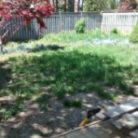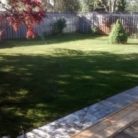Consider the option of using fescue sod (shade grass) for your lawn if you are not installing a water system in:
Mineola, Lorne Park, Port Credit, Applewood, Lakeview, Cooksville, Clarkson
Topics on This Page
Watering Your Newly Sodded Lawn
Landscaping Ideas to Add to Your New Yard
Steps to Installing a New Lawn
Things to Do After the Sodding has Been Laid
Beginning the Plans for a New Lawn
Some yards have not been properly watered or tended to and are now covered in weeds and bare spots.
Maybe you have renovated and the yard is in rough shape and requires full design work.
Old tree roots and ground digging animals have made the lawn bumpy and uneven.
When you have finally decided to install a new sodded lawn to remedy this issues it is important to give some thought into what other areas of the yard could be altered at the same time. It is a great opportunity to look at any of the landscaping ideas you may have thought about.
In this day of banned herbicidal products, possibly replacing as much lawn as possible with alternative forms of ground cover may be something to consider.
[su_spacer size=”80″]

Watering Your Newly Sodded Lawn
Water is a very important aspect of things going well with your newly sodded lawn. Proper watering is very important for the first 3 weeks in order for the new sodded lawn to be well established in 30-45 days.
Nature’s Watering
The difference between seeding and sodding is that seed only needs to only be moistened frequently for the first 3-4 weeks. Your new sod however will need to be soaked daily for the first few weeks. Then after the first 3 weeks your new sodding will need to be well watered 2-3 times a week depending on the amount of precipitation you get in your area. The ground needs to be squishy under your foot when it has had enough water.
Once your lawn is established one good soaking weekly for 3-4 hours with a good full coverage sprinkler with even more in the hot heat of summer is what is needed. The long watering period allows the water to soak deep down in the soil in order for your grass roots to have to grow strong and long in order to reach water. The grass will become healthy and will grow thick.
Less water, much more frequently and you will encourage the roots to stay short and near the surface, they may be sustaining life but they will not grow into thick dense grass plants. By allowing your grass roots to become strong an infestation of weeds and grubs will not destroy your lawn because your lawn will be strong and thick with a great rooting system enough to withstand more than someone’s lawn that has not had proper watering.
Things to Do After The Sodding has Been Laid
After your sodding has been laid, unless precautions have been taken, squirrels and skunks may come along in the evening to enjoy the buffet of bugs that they hope are under the sod. you must ensure their midnite snack happens somewhere else.
Placing pegs to hold it down will help. Covering an area with screening and then pegs to hold it down may help. I have heard of some people using cayenne pepper to toss around the area they have been to discourage their visiting. My father in-lawn used to stay up at nite sitting outside with a pitchfork to protect his grapes. There are many ways. If you have a good way to keep the cridders away let me know, could you place a comment below?
Within the first few weeks your new lawn will need to be cut. Do not cut it too short! 3 inches would be best. Possibly bagging these first few cuts may be good as the lawn should be quite thick and long with all the water being applied. Then cut it every 4 or 5 days. It should be growing long during this period because of all the water you are putting on in order to grow the grass roots. Make certain as well that your lawn gets fertilized in the fall and again in the spring. Fertilizing a few times a year is great for your new lawn. If you only want do it one a year fertilize well in the fall
We want your lawn sodding project to look great for years to come.
Landscaping Ideas to Add to your New Yard
- If you lawn has been slowing dying because of lack of watering than it is a great time to adding a sprinkler system.
- We have had much success growing Hostos or Euonymus in these shaded areas under trees. These are all low maintenance ideas.
- Maybe adding decorative landscape stones positioned around a tree that you know is determined to never give your newly sodded lawn a chance to grow under it. Fescue Grass Seed will be the only grass growing under a tree.
- Many may choose to extend their driveways. I for one believe in less grass the better, no watering, weeding or cutting required when you add more ashfelt or paving stones.
- Maybe adding a few shrubs like a Burning Bush or Weigela to add some colour and liven up the area.
- Extending your current flower garden or maybe even reducing the one you have.
- Planting a new Japanese Maple tree, or a unique Tri-coloured Beach tree.
- Possibly a few walking stones on a well traveled pathway that never seems to grow grass.(a must)
Steps to Installing a New Lawn
- The old sod will be removed and taken away to the dump.
- The drainage and slop of the lawn is a major aspect that needs to be addressed at this starting point.
- Heavy rains have become more important over the past few years. Plan for the worst and hope for the best.
- Plant your new shrubs and trees.
- Level the soil
- You may also have to add soil if the grading has determined it.
- Most people have fairly good soil underneath but a good top soil will not hurt the cause.
- If you live in a new subdivision the builder may have laid your sod on garbage (very rocky filler soil) so please add good soil
- You may need to add a good top soil for grading and ensure to compact it well.
- Adding too much triple mix will make the soding very mushy when wet and could leave holes. This will be a real problem.
- For faster knitting of your sod to soil we will roller the sod in order for the new sod to make good contact with the soil.
- Stepping stones can be installed after the sodding is laid. Sod needs to be laid as quickly as possible to avoid drying out.
To see if you live within our service area click on Contact Us button on top right.


